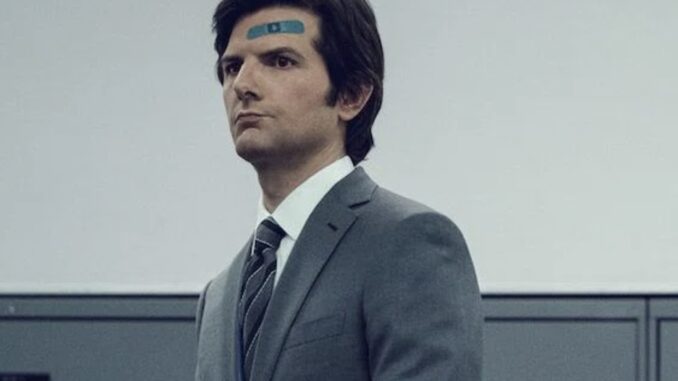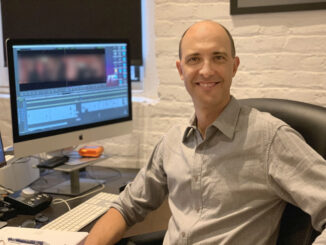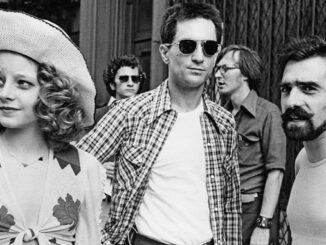
By Rob Feld
In “Severance,” the picture editors Geoffrey Richman, Gershon Hinkson, and Erica Freed Marker had a singular opportunity to define the look and feel of a singular series. The footage they received from director Ben Stiller was inspired and inspiring, but not necessarily what they expected. “You read a script and pictured in your mind how it would be framed or progress from one angle to another,” recalled Marker. “But then the dailies come in and not a single shot corresponds to what you imagined, because Ben is just so inventive.”
Richman was brought onto the show first, previously having worked with Stiller as a director on “Escape at Dannemora.” “‘Dannemora’ had its own unique feel to it, too, but when I started getting the early dailies on ‘Severance,’ I was blown away. It was still Ben, still Jessica Lee Gagné as DP, but a completely different language and feel that also felt unique and relevant to the world of ‘Severance’.”
“It was off center or unconventional,” said Hinkson. “While ‘Severance’ doesn’t land directly in the middle of the thriller, comedy, or sci-fi genre, the series does combine all three. In no small part due to the gift of the footage and the performances we received, I’d like to think that as editors, we were able to forge viable links between the genres.”
“Severance” is a workplace thriller set at Lumon Industries, a company whose employees have undergone a severance procedure, which surgically divides their memories between their work and personal lives, which its protagonist, Mark [Adam Scott], uses to escape the tragic loss of his wife. Dissatisfaction lingers, however, and he and his colleagues find themselves amidst a dangerous, unraveling mystery and, in the blindness of their severed selves, proceed to investigate. The series won critical acclaim after its premiere earlier this year on Apple TV+ and has been renewed for a second season.
The team of editors, separated physically from each other during the COVID-19 pandemic and receiving footage that would fall throughout the first season’s nine episodes—rather than being able to build discreet episodes one at a time—set about finding a language. The approach was both radically exploratory and intuitive, and in ways more deeply collaborative due to their very separation. The result is unique, unexpected, and effective.
CineMontage: Tell me about your first reactions to the footage you were receiving.
Geoffrey Richman: One of the first scenes shot was in Episode One, of Mark coming home after a day at Lumon. I remember being excited by all these interesting visuals, frames within-a-frame, shots centered and not-centered and split in half. It was a very simple scene, Mark enters the house, grabs a beer, and watches TV, but already on day 1 of shooting you got a sense of what the look of the show was going to be, and this was even before setting foot in Lumon. When I read the script, I was concerned about the MDR office location because so much of the story takes place in that one room. But there were many times watching the dailies where I couldn’t recognize where we were in MDR because it was shot from so many unique angles. Even in that same room, ultimately no scene looks the same across all the episodes.
CineMontage: So how do you keep an audience oriented in this disorienting space, and what’s your barometer for choosing a shot progression or an angle to build from?
Richman: It’s different for every scene obviously. But in general, it’s a feeling when you’re watching it: where do you want to be at any given moment? You might start by building a scene around one amazing wide shot, then once it’s in the context of the shots around it, you get a feel for how long you should hold before you start to feel disconnected from the scene, so you go in closer. With so many angles to choose from, sometimes it’s about keeping the progression from feeling too presented or traditional, or predictable. So you say, If we can’t go from the wide to this more traditional closeup, how can we get into the characters in a way that still feels true to the uniqueness of the coverage, which won’t feel presented or stagey?
Gershon Hinkson: Geoff brings up a great point about needing to avoid building sequences that would feel too presented or traditional. In some of my early assemblies I did just that and would work with sound or music to create something psychological. I knew that something needed to be done to throw my ‘traditional’ sequence ‘off center,’ but I wasn’t there yet. As more footage came in and episodes began to fill out more, it became clearer what the approach needed to be. Getting into the characters in a way that preserved the uniqueness of the coverage was the key. I saw it develop in Geoff’s first episode and locked into it.
Richman: The great performances definitely made it harder to whittle the takes down. We’d do multiple versions of the scene just to see what pinged and how shot combinations performed differently. Episode One, there’s a scene of Mark and Petey [Yul Vazquez] in the diner. Ben shot tons of coverage of it: lots of interesting angles inside the diner, one with glasses in the foreground, an extreme-wide shot from outside the diner, closer two-shots. In early cuts of the scene, I included a lot of those angles. But as Ben and I worked on the scene, the performances were so strong, it felt better keeping the whole scene in close-up. It just called for that kind of coverage.
Erica Freed Marker: I think what motivates a cut even with this different footage is the same: it’s always for performance or reveal. The shot selection and progression could be different but motivation remains the same. I would say the exception is the Lumon set, which is never-ending white, and the intention might be to disorient—like people appearing beside someone, coming around a corner in these white hallways. So, there might be only two shots that can pull off that reveal.
Hinkson: It’s really leave no stone unturned. We’ve probably tried every version of the scene.
Richman: Often you can’t predict how it’s going to play out, and it’s fun to be surprised by setting aside the version you think it should be and trying it in a completely different way.
CineMontage: What’s the greatest challenge of handling this footage, then?
Marker: Calibrating the exact pace at which characters should be angry at each other and then soften toward each other. Like when Helly [Britt Lower] and Mark first met; she’s so angry and upset, and she tries to escape. Then there’s a moment where Mark softens toward her and starts to flirt. There were so many ways to play that where you could see them connecting. I cut that scene so many times because I loved seeing them connect. In my first pass, I built that connection with such excitement but then realized I had to dial it back. There was a long way to go, so much growth in the characters and in the development of the relationship, before they could get there. Fine tuning that exact pace was hard.
Hinkson: One of the biggest challenges was constructing sequences that could exist at the intersection of three genres. At times humor needed to be made unsettling, the bizarre had to be made plausible and scenes needed to be emotionally agile. In Episode 2 for example, at Helly’s welcome party, Mr. Milchick becomes the catalyst for turning a light moment into something unnerving by putting Mark on the spot in front of everyone only to laugh the whole thing off, leaving Helly very suspicious. The scene needed to be funny, creepy, and intense. Performances, music, shot selection and pacing were revised individually and collectively several times until the move from emotion to emotion flowed without effort.
CineMontage: What were you calibrating shot to shot, then? Lines? The performances?
Marker: Performances; it wasn’t lines. The actors gave such a range, and everything was usable. Patricia Arquette as Cobel does that, too. She could be so funny and then so deeply dire in the same scene. And you have to decide which way to take it. Usually, it was somewhere in between. But then we would see the whole thing, go back, and recalibrate.
Richman: A big obstacle was presented by the way they shot all the episodes simultaneously in block shooting, so we didn’t have complete episodes until the entire shoot was done. So, it was exciting when another piece of the puzzle came in that would fill in a run, so you could actually watch more than a few minutes at a time. Then you could get a sense of what the flow of the episode would be. Without that, you could be a little handicapped getting the overall flow.
CineMontage: There was a somewhat unique process to integrating the music, right?
Richman: I’d never worked on a show where the composer was on and writing music before shooting started. But before the first day of shooting, we already had a Dropbox folder full of music that we could listen to and get a sense of the tone of the show. Teddy [Shapiro] would be scoring entire suites, and the bin kept getting bigger—suites for different moods, tempos, movements, feelings. He would give us those cues broken down into all their individual stems so that we could deconstruct them. And that’s what we cut to. Then as we got closer to finishing a director’s cut of any given scene, we would send the scene to Teddy with his music, and he would refine it to be more specific to that scene. The next day you’d have a fully scored version of the scene that would completely transform it. The music defines the tone so much. One thing that Teddy did that was just brilliant, is meld different tones. For example, in Episode Three, the MDR and O&D departments round the corner and face off in the hallway. It has this tension in the music. But then when it goes to shots of Irving and Burt, their romantic theme plays on top of it, so you have both happening at once. That’s the nature of the show: all these different tones happening at the same time, or changing fluidly. Working with the music really enabled that.
CineMontage: How did you collaborate, especially during the pandemic?
Marker: We were all remote, which in a weird way supported intense collaboration because we weren’t all stuck in our own edit rooms. We were all online looking at things all the time, and we had to look at each other’s stuff constantly to be sure we were all on the same page because the tone was so specific. Geoff was on first, so I referenced his cuts the most because he was paving the path and I wanted to make sure I was following it. In real life, you would walk into someone’s room and you say, let me see this. Remotely, we were looking at the cuts, which is really informative versus standing in the back of a room saying, Oh, that works great. Here, you could look at the timeline and saying, Oh, I see what you did! I can implement that too. You’re not saying to your assistant, “Hey, can you pull the sound that I saw in Episode One?” You’re watching it and seeing how it was used, so now I’m going to do something either exactly the same or different in this episode as it requires.
Richman: That’s a good point. You could see people’s intentions more when you’re looking at the cut in the timeline.
Marker: Working on a TV show is fun like that because it’s collaborative and you do have teammates. You’re not an island unto yourself like on a film.
Hinkson: I think the operating thing here is team. If we weren’t wired that way going into this, or if that wasn’t established from the beginning and it turned into some sort of a competition, we would have failed miserably.
Richman: There was a shared understanding of where we were all trying to get. So even though we were working on different episodes, we all knew what the problems were coming up down the road.
Hinkson: Episode by episode, we were getting the idea of what the world was, the rhythm and pacing, and the intention for the viewer’s experience. In the very beginning, having footage but needing to figure out how to use it took work but because it was a team effort, we benefited from insightful discussions about approach and intention. Oh, and a lot of shared humor, which was a huge help.






